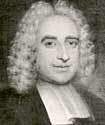<Back to Index>
- Philosopher Willem Jacob's Gravesande, 1688
- Painter Théodore Géricault, 1791
- General Field Marshal Johann David Ludwig Graf Yorck von Wartenburg, 1759
PAGE SPONSOR

Willem Jacob 's Gravesande (26 September 1688 – 28 February 1742) was a Dutch philosopher and mathematician.
Born in 's-Hertogenbosch, he studied law in Leiden and wrote a thesis on suicide. He was praised by John Bernoulli when he published his book Essai de perspective. In 1715, he visited London and King George I. He became a member of the Royal Society. In 1717 he became professor in physics and astronomy in Leiden, and introduced the works of his friend Newton in the Netherlands. He opposed fatalists like Hobbes and Spinoza. In 1724, Peter the Great offered him a job in Saint Petersburg, but Willem Jacob did not accept.
His main work is Physices elementa mathematica, experimentis confirmata, sive introductio ad philosophiam Newtonianam or Mathematical Elements of Natural Philosophy, Confirm'd by Experiments (Leiden 1720), in which he laid the foundations for teaching physics. Voltaire and Albrecht von Haller were in his audience, Frederic the Great invited him in 1737 to come to Berlin.
His chief contribution to physics involved an experiment in which brass balls were dropped with varying velocity onto a soft clay surface. His results were that a ball with twice the velocity of another would leave an indentation four times as deep, that three times the velocity yielded nine times the depth, and so on. He shared these results with Émilie du Châtelet, who subsequently corrected Newton's formula E = mv to E = mv2. (Note that though we now add a factor of 1/2 to this formula to make it work with coherent systems of units, the formula as expressed is correct if you choose units to fit it.)